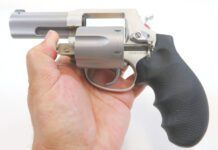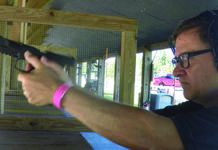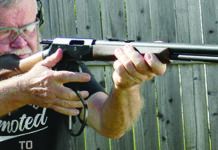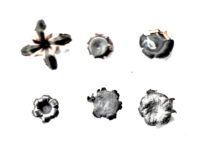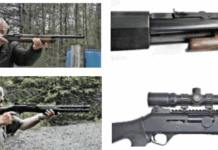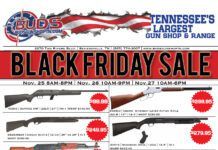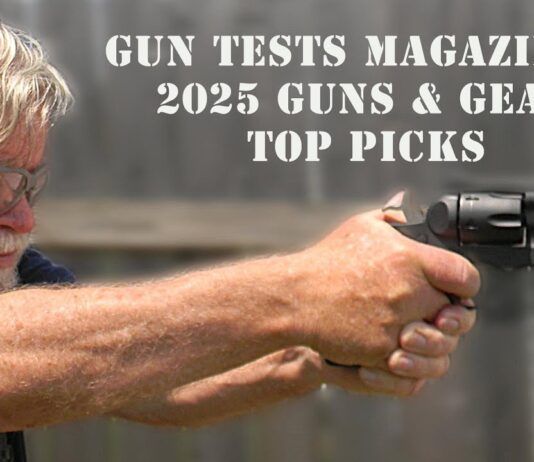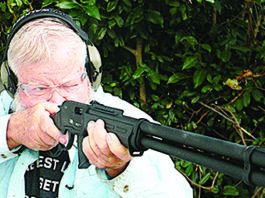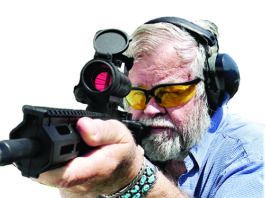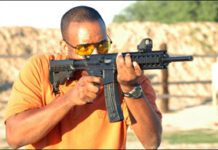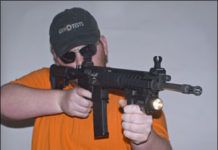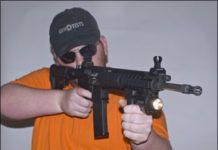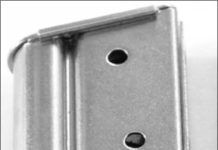Fulton Armory FN Special Police Rifle .308 Win.
Tactical-Style 22 LR Carbines: Ruger, S&W, Legacy Duke It Out
Thompson Center’s Hotshot Youth Rifles
Any serious shooter knows that it's perfectly plausible (and safe) to teach a pre-teen to shoot. Thompson Center knows it, too, and that's why they've introduced a new product called the HotShot rifle, a single-shot rimfire aimed at the young shooter. In this gunreports.com product minute video, you can find out about the basics.
DIG v. GPS: Are Gas-Piston ARs Worth Their Premium Prices?
DIG v. GPS: Are Gas-Piston ARs Worth Their Premium Prices?
Santa and His B&C Sleigh
Four M1 Carbines: CMP, Fulton, And Auto-Ordnance Compete
The M1 carbine was the most prolific U.S. weapon of the WWII era, with six-odd million made, and it's still very popular today. It employs an anemic round by rifle standards, but—per its design—its cartridge is at least as powerful as most handgun rounds. Today's buyer of a genuine WWII-era or Korean War era carbine will probably need to spend around a thousand dollars, give or take a few hundred, for a reasonable example. On GunBroker we saw prices from about $750 to$1400, depending on condition and rarity. However, if you're qualified, and if you hurry, you may be able to get a decent carbine for about $420-675, through the Civilian Marksmanship Program (CMP) sales. This outlet used to be called the DCM, Director of Civilian Marksmanship, run by the U.S. government, but that program is now in private hands. However, due to the nature of the program, the CMP carbines may be in very short supply by the time this report appears in print.
Do you qualify for a CMP firearm purchase? Taking the CMP requirements straight from the website (www.thecmp.org), "By law, the CMP can sell surplus military firearms, ammunition, parts and other items only to members of CMP-affiliated clubs who are also U.S. citizens, over 18 years of age and… legally eligible to purchase a firearm." For more information, visit the website.
For this test we acquired four carbines. We had on hand a Fulton Armory carbine, with an original Underwood barrel in near-perfect condition. But if you want a Fulton-built M1 carbine today you'll have to get it with the new Fulton barrel ($1300). All of the original mil-spec barrels are apparently now gone. Two of our carbines came from the CMP, both "Service Grade." One was an Underwood (CMP-1, $565) and the other an Inland (CMP-2, $ 495). The so-called "Rack Grade" carbines are a bit less expensive. Finally, we acquired a new Auto-Ordnance AOM130 M1 Carbine ($899) with beautiful walnut stock and newly manufactured metalwork.
In our testing of these four M1 carbines, we found many similarities and a few differences. There were two types of safeties. One was the swinging-arm or "flip" type, which requires pulling a small lever rearward to put the gun into the firing position. This is easily accomplished with the right index finger, by right handers, and fairly easily by the trigger finger of lefties. The second safety type was the crossbolt, similar to that found on many pump shotguns. This required pressing to the left to fire, which we found could not be done as easily by lefties. The Auto-Ordnance and Underwood (CMP-1) carbines had the push-button safety. The Auto-Ord and Underwood also had the flat bolt, and neither of these two had a bayonet lug. All the guns except the Auto-Ord had the stepped, windage-adjustable rear sight. The A-O had a modern-made, two-height sight similar to the original M1 carbine sight, which had to be drifted for windage. The two CMP carbines had a stamped base for the adjustable rear sight. The Fulton had a milled base. The Underwood (CMP-1) had a sheet-metal trigger guard. All had the wing-protected front sight.
We tested with three types of 30 US Carbine FMJ "ball" ammunition, all of it 110-grain loads. It was from Sellier & Bellot, American Eagle, and original U.S. Mil-Spec ball (head stamped LC71). Because the two CMP carbines came without magazines, we used an original Winchester 15-round magazine for all our testing, with one exception explained below.
Generally speaking, here's what we think. Those who like shooting military type firearms really owe it to themselves to have an M1 carbine. They're a lot of fun. Good ones need not break the bank, but in an era where the SKS rifles that used to go begging at gun shows for $85 now bring upwards of $400, the price of an M1 carbine is not outlandish, even at the over-a-grand mark. We suggest you act soon, particularly if you want one from the CMP. They're going fast.
Details on the four guns we tested follow:
Four M1 Carbines: CMP, Fulton, And Auto-Ordnance Compete
The M1 carbine was the most prolific U.S. weapon of the WWII era, with six-odd million made, and it's still very popular today. It employs an anemic round by rifle standards, but—per its design—its cartridge is at least as powerful as most handgun rounds. Today's buyer of a genuine WWII-era or Korean War era carbine will probably need to spend around a thousand dollars, give or take a few hundred, for a reasonable example. On GunBroker we saw prices from about $750 to$1400, depending on condition and rarity. However, if you're qualified, and if you hurry, you may be able to get a decent carbine for about $420-675, through the Civilian Marksmanship Program (CMP) sales. This outlet used to be called the DCM, Director of Civilian Marksmanship, run by the U.S. government, but that program is now in private hands. However, due to the nature of the program, the CMP carbines may be in very short supply by the time this report appears in print.
Do you qualify for a CMP firearm purchase? Taking the CMP requirements straight from the website (www.thecmp.org), "By law, the CMP can sell surplus military firearms, ammunition, parts and other items only to members of CMP-affiliated clubs who are also U.S. citizens, over 18 years of age and… legally eligible to purchase a firearm." For more information, visit the website.
For this test we acquired four carbines. We had on hand a Fulton Armory carbine, with an original Underwood barrel in near-perfect condition. But if you want a Fulton-built M1 carbine today you'll have to get it with the new Fulton barrel ($1300). All of the original mil-spec barrels are apparently now gone. Two of our carbines came from the CMP, both "Service Grade." One was an Underwood (CMP-1, $565) and the other an Inland (CMP-2, $ 495). The so-called "Rack Grade" carbines are a bit less expensive. Finally, we acquired a new Auto-Ordnance AOM130 M1 Carbine ($899) with beautiful walnut stock and newly manufactured metalwork.
In our testing of these four M1 carbines, we found many similarities and a few differences. There were two types of safeties. One was the swinging-arm or "flip" type, which requires pulling a small lever rearward to put the gun into the firing position. This is easily accomplished with the right index finger, by right handers, and fairly easily by the trigger finger of lefties. The second safety type was the crossbolt, similar to that found on many pump shotguns. This required pressing to the left to fire, which we found could not be done as easily by lefties. The Auto-Ordnance and Underwood (CMP-1) carbines had the push-button safety. The Auto-Ord and Underwood also had the flat bolt, and neither of these two had a bayonet lug. All the guns except the Auto-Ord had the stepped, windage-adjustable rear sight. The A-O had a modern-made, two-height sight similar to the original M1 carbine sight, which had to be drifted for windage. The two CMP carbines had a stamped base for the adjustable rear sight. The Fulton had a milled base. The Underwood (CMP-1) had a sheet-metal trigger guard. All had the wing-protected front sight.
We tested with three types of 30 US Carbine FMJ "ball" ammunition, all of it 110-grain loads. It was from Sellier & Bellot, American Eagle, and original U.S. Mil-Spec ball (head stamped LC71). Because the two CMP carbines came without magazines, we used an original Winchester 15-round magazine for all our testing, with one exception explained below.
Generally speaking, here's what we think. Those who like shooting military type firearms really owe it to themselves to have an M1 carbine. They're a lot of fun. Good ones need not break the bank, but in an era where the SKS rifles that used to go begging at gun shows for $85 now bring upwards of $400, the price of an M1 carbine is not outlandish, even at the over-a-grand mark. We suggest you act soon, particularly if you want one from the CMP. They're going fast.
Details on the four guns we tested follow:


